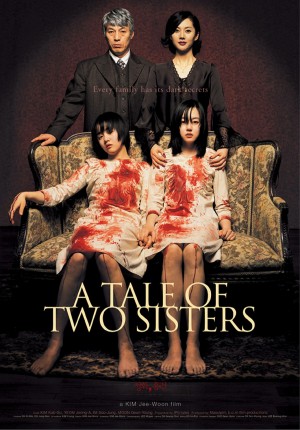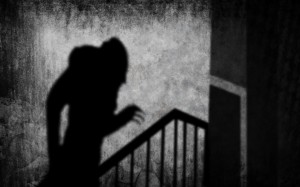Now that Halloween is here, what better way to celebrate than to catch a scary movie? Whether you’re planning to spend the night in or out, here’s a mosaic of five spooky and critically acclaimed films from a variety of subgenres, countries, and eras to complement anyone’s night of fright.

A Tale of Two Sisters (2003)
This psychological thriller, directed and written by Kim Ji-woon, hails from South Korea, where it holds the title of the highest-grossing horror film—and, for those keeping score, it has been nominated for (and won) over a dozen awards in film festivals all over the world. A Tale of Two Sisters is a modernization of a haunting ancient folktale called “Janghwa Hongryeon jeon,” a story about the drowning of two sisters. The same eeriness and unsettling details that are laced through the lore are featured in this movie. Set in a quiet lake house, it begins with Su-mi and Su-yeon returning home from psychiatric hospitalization. They soon discover violent, disturbing apparitions in their home and in the presence of their cruel and abusive stepmother. This story moves with constant velocity, but with minimal dialogue; director/writer Ji-woon uses silent dreamlike sequences—mysterious medication, trails of blood in the hallway—to unveil the dark secret torturing the two sisters. The ending is agonizing and satisfying, with a plot twist that is as disquieting as it is poetic.
Let the Right One In (2008)*
This Swedish film from director Tomas Alfredson (based on a John Ajvide Lindqvist novel of the same name) takes the innocent and nostalgic notion of first love and debauches it. In 1980’s Blackeberg, a suburb of Stockholm, lonely 12 year old Oskar meets his new neighbor, Eli, a strange girl who fascinates him. The two quickly become friends. As their friendship buds into a harmless romance, it becomes more and more apparent to Oskar that Eli is not a normal girl. Scenes of muted violence reveal that she is a vampire who relies on an old man to bring her blood. He collects the blood in plastic milk jugs, seemingly symbolic of the film’s motive of revealing the inhumanity that can hide in places as mundane as suburbia. Oskar has his own violent secrets (and his are perhaps more disturbing). An outcast at school and a victim of bullying, he spends his nights fascinated over a pocket knife, stabbing trees and putting on odd masks as he wields his weapon, apparently imaging himself seeking revenge on his tormenters. Eli and Oskar’s violent tendencies and loneliness draw them closer to one another. The bleak, echoing world that Alfredson crafts speaks volumes about the young love that appears to end happily, but is actually riddled with dark, unnerving innuendos.
The Silent House (2010)
The Silent House, a Spanish-language film with direction from Gustavo Hernández, is supposedly based on real events which occurred in the 1940’s in a small village in Uruguay. It centers on a woman named Laura and her father, Wilson, who have settled in a small cottage with intentions of making repairs to it. During the night they spend there, they hear sounds coming from upstairs and Wilson goes to investigate. Laura is left alone. The film focuses on Laura’s time in the decrepit house as she slowly discovers its dark secrets while trying to escape from them. The most breathtaking cinematic element of The Silent House is that it is shot entirely in one continuous seventy eight minute take, with absolutely no cuts or edits. As the viewer experiences everything as Laura experiences it, the scenes of suspense are greatly heightened. There is no editing to distract from what is actually happening; rather, a sense of realness and authenticity, reminiscent of horror flicks like The Blair Witch Project, permeates each turn of her dim lantern to reveal what terrible secrets lies in the darkened rooms of the house.

Nosferatu (1922)*
The story opens in the Carpathian Mountains. Real estate agent Hutter, who has arrived to close a sale, ignores the warnings of the townspeople and journeys up to the dark castle of the mysterious Herr Orlock. During their meeting, Hutter clumsily slices open his finger and draws blood. At this point, Orlock’s true nature is revealed. The story continues with Orlock’s travels to the town of Bremen, where bodies of half devoured men are discovered; but the authorities attribute their deaths to plague. However, Hutter’s wife, Ellen, knows better and becomes determined to destroy the vampire. A prime example of German Expressionism, F.W. Murnau’s Nosferatu, eine Symphonie des Grauens (translation: Nosferatu: A Symphony of Terror) features some of the most recognized sequences related to vampire films—for example, the shot of Nosferatu’s shadow skulking up the staircase. This film is commonly associated in modern day with the Dracula franchise despite the fact Murnau constructed it as a separate entity. As a film history side note, the wife of Dracula’s author Bram Stroker believed that Murnau had plagiarized her husband and demanded that his movie be suppressed and all copies be destroyed. Regardless of this criticism, Nosferatu has survived throughout the years as a horror classic. The film’s eeriest element is the appearance of Count Herr Orlock, which is still one of cinematic history’s most abhorrent disguises. His long fingers, thin teeth and pale eyes achieve far more sinister effects than the story, and will definitely haunt the audience long after the credit roll.
The Shining (1980)
Arguably, any anthology of horror is incomplete without some Stephen King, and there is no better example of classic King than The Shining. This Stanley Kubrick adaptation features Jack Nicholson as Jack Torrance, a struggling, uninspired writer who takes a job as a caretaker of the secluded Overlook during a thick winter. He takes his family along with him, including his young son, Danny, who seems to possess psychic abilities (which are referred to as “the shining”). As the isolation wears on them, the family experiences a succession of supernatural visions; some are upsettingly odd, some are appallingly violent, but all are undeniably disturbing. It’s the suspense, the paranoid atmosphere, and the ethereal soundtrack that makes this film so terrifying. To top it all off, Jack’s famous axe wielding scenes give this movie the added bonus of being a particularly well-made slasher flick. While King intended The Shining to be a ghost story, producer and director Kubrick an adaptation with far more plot obscurity. Is it a ghost story? Or is it something more sinister and psychological? This has been widely debated by movie buffs for years since its making. But one thing is undeniable: apart from being a great scary movie, it is also rich with metanarrative, social commentary, and intriguing ambiguity.
*These titles are available on Netflix Instant Streaming.


Didn’t Nicolas cage make some great scary movies?